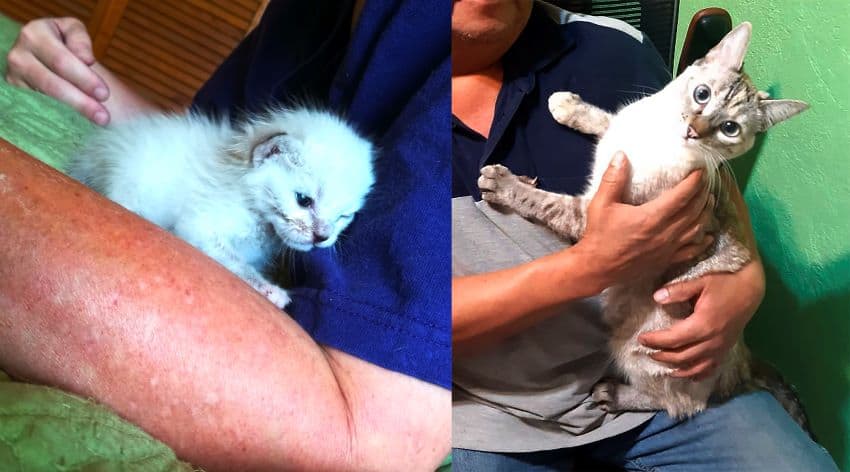Mexico shares this problem with the rest of the world: too many cats and not enough homes.
A year ago, on a chilly morning, I found a one-week-old kitten abandoned on the steps of a bar. Despite already having three cats in a small Mexico City apartment, I scooped her up. She survived, but the cat gods decreed (despite our best efforts) that she would remain with us. Her name is Indiana.
My posts about her on Facebook got the attention of a National Autonomous University (UNAM) graduate student doing testing on kitten development. She told me that Indiana was indeed very lucky since many kittens are born and abandoned to their fate at this time of year.
“Kitten season” refers to one or more seasons when more kittens are born. Domestic cats can and do give birth year-round, but both temperature and varying day length play a role in estrus cycles.
These factors are not country-specific, with similar patterns found in similar environments around the world. Places with a significant winter may see only one period of time when kittens abound. Warmer climates may see a longer season and even two seasons. There are no studies on feral cat behavior specific to Mexico, so vets and other experts refer to studies done mostly in the U.S.

Mexico has a wide range of climates, from tropical to those which see freezing temperatures even in the daytime. But due to the role that lengthening days plays, animal rescue workers see an uptick in kittens in the spring even in tropical areas such as the Yucatán.
There are no studies on cat fertility in Mexico per se, but several veterinarians that I spoke to believe that tropical temperatures and rainy seasons probably do have an effect on when more kittens are born. The central highlands region, which includes Mexico City, tends to see one significant season running from March to May or June. There is a second somewhat sporadic season between August and September because of other factors, such as the rainy season and the weaning of spring kittens.
In Mexico, cats are a distant second to dogs in popularity. According to the national statistics service, Inegi, 57% of homes have at least one pet, but only 15% of these homes have a cat. But their popularity is growing as the population becomes more urban and they are perceived as being easier to care for than dogs. The government estimates that there are over 10.5 million cats nationwide.
There are no stats for cat homelessness, but the Mexican Association of Veterinary Medicine Specialists in Small Species estimates that of the 23 million dogs and cats in Mexico, only 30% have a home. Animal abandonment is a huge problem in Mexico. Most abandoned cats are kittens born to owners’ unspayed females, and according to Inegi, the number of strays and feral animals increases 20% annually.
Although a smaller percentage of Mexican households own cats, that does not mean that the problem of stray and feral cats is proportionally smaller compared to that of dogs. Cats produce anywhere from four to eight kittens per litter on average. They can, and often do, give birth to multiple litters of kittens each year and can start having babies at as young as four months. Allowed to breed naturally, a female can give birth to anywhere from 50–150 kittens in her lifetime.
High fertility rates are accompanied by high kitten mortality rates. According to a North Carolina survey of kitten survival studies, anywhere from half to 90% of kittens die or disappear by the age of six months. The most common observed causes of death are dog attacks and car accidents, but these may be overrepresented. Cats hide when sick or injured and are prey for a number of wild species. These probably account for many of the disappeared.

Strays are relatively rare in the center of Mexican cities. One reason is that there is some animal control, but I also suspect that in places like Mexico City, it is even harder to survive than elsewhere. Once outside city centers, the number of stray and feral cats increases dramatically as many people abandon their unwanted, thinking they will have a better chance of survival. In the case of kittens, they are often abandoned, without their mothers and without hunting skills, and are the right size to be prey for other animals.
Kitten season means a rise in abandoned litters because most cats are simply not sterilized, including purebred cats left outside, says Dr. Miguel Ángel Sierra of UNAM, who is noted for his efforts to raise consciousness about the problem. One understandable reason cats are not spayed is that poor families cannot afford the expense, but myths about sterilization (animal will gain weight, get cancer, etc.) are prevalent here as well. Mexico’s Ministry of Health offers free and low-cost sterilizations but cannot reach most of the millions of feral cats out there.
With kitten season upon us, shelters and cat rescues are particularly short of donations and hands. If you are willing and able to adopt a kitten, consider getting two as the little ones are energetic and need the stimulation. Indiana still gets into mischief a year later.
Fast forward a year, and I find yet another kitten — a four-week-old — in a flowerpot near a busy intersection. Despite us having four cats, she gets scooped up as well.
This time, however, the cat gods are merciful: we found Cannoli a wonderful home within 24 hours.
Leigh Thelmadatter arrived in Mexico 17 years ago and fell in love with the land and the culture. She publishes a blog called Creative Hands of Mexico and her first book, Mexican Cartonería: Paper, Paste and Fiesta, was published last year. Her culture blog appears regularly on Mexico News Daily.
